Like many things in life, blogging is easier said than done.
You might have a great concept for a post, but when it comes time to write it, it just doesn’t come out the way you want it.
Or even worse, you get a nasty case of writer’s block and spend hours staring at a blank page with nothing to show.
If you’re having trouble getting the gears turning for your blog, then keep reading.
This article will teach you everything you need to know about writing your next blog post and give a few insightful examples to encourage and inspire you.
Contents
Blog Post Basics: A Primer
First, we need to start with the basics.
A fundamental understanding of blogging will help you structure your posts better and allow you to write more smoothly.
What is a Blog Post?
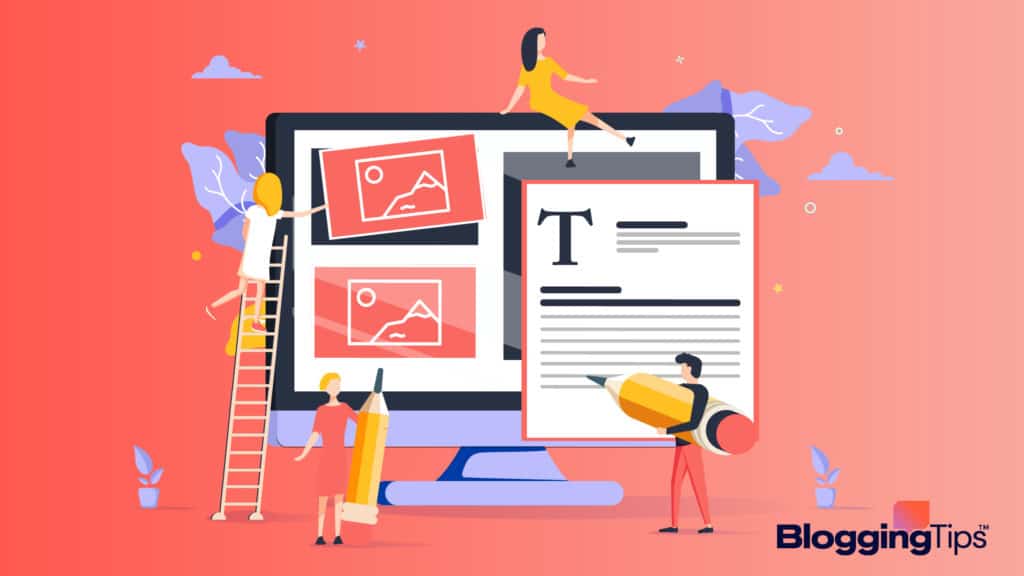
A blog post is a short blurb of information posted on the internet as part of a larger chain of posts, aka a blog.
The content of a blog post usually pertains to a theme that can change from Blog to blog.
Food, travel, sports, tv shows, and music are some of the most common types of blogs, though you can find a blog on just about anything.
How Do You Write a Blog Post?
For a general overview of how to write a blog post, here is a list of steps.
- Step 1. Choose an idea.
- Step 2. Research your topic, and target audience, and check out similar articles.
- Step 3. Create a title and an outline.
- Step 4. Implement keywords to optimize searches of your topic and reach your target audience.
- Step 5. Write a final draft. Your post shouldn’t be too long and contain original content.
- Step 6. Edit and polish the draft.
- Step 7. Design how it looks on the web and publish.
What Should Be Included in a Blog Post?
No blog post is the same; each one will contain different materials.
As a general rule of thumb, most blogs should have a relevant title, a captivating headline, hyperlinks, embedded media (pictures, videos, music, etc.), keyword-based metadata, sub-headings, and end with a light call to action.
How Long Should a Blog Post Be?
Blog posts should be concise and straight to the point.
There shouldn’t be any technical jargon (unless the post is for a specific niche) or fluff/filler text.
Each thought should be about 2 – 4 lines long and separated by multiple headings.
While the length may vary from post to post, the average high-ranking blog post usually falls between 1500 and 2000 words.
Blog Post Templates
Blog posts can be an irritating and tedious process regarding formatting, but you can save a lot of time and effort using templates.
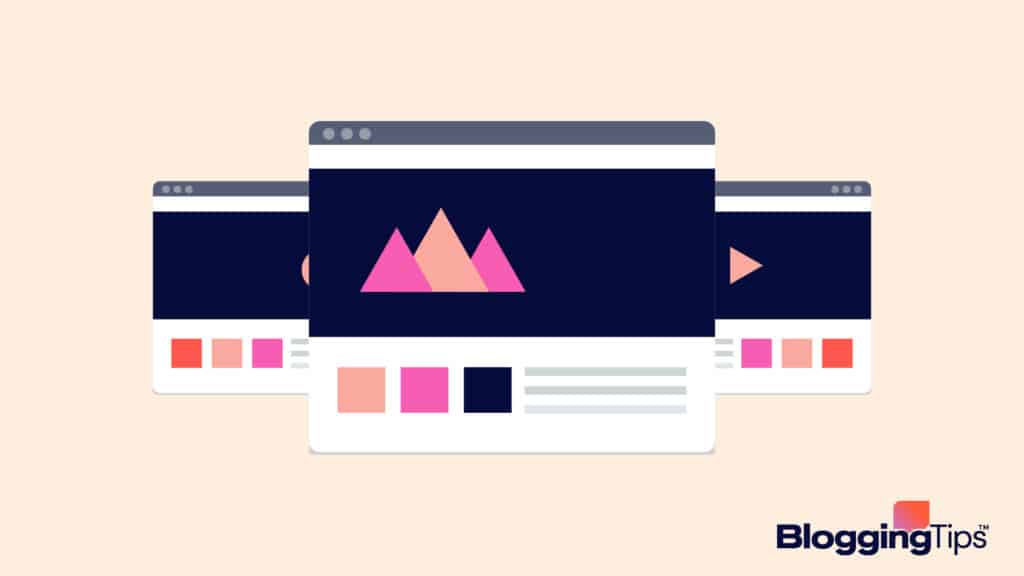
What is a Blog Post Template?
A blog post template is a pre-designed writing formula to help you organize and structure your writing.
It’s like a pre-existing mold you pour your original content into, then customize.
Templates are proven methods that many bloggers use to unlock their content efficiency.
How Blog Post Templates Unlock Efficiency
Templates save tons of time and effort by organizing your work and providing bloggers with a foundational starting point where you don’t have to stare at a blank page for all eternity.
Templates also work with search engines, meaning a proven format is most likely to rank higher in Google searches and create more organic traffic.
Parts of a Blog Post Template
There are four main parts of every blog post template:
- Blog Post Topic: A compelling title that draws readers in and lets them know the subject of your post.
- Introduction: The introduction aims to give a general overview of the post’s content and prompt visitors to read further.
- Body Content: The body content is the meat and potatoes of the blog post. Content should be as in-depth as possible and consist of high-quality content, keywords, and headings.
- Conclusion: The conclusion gives final thoughts, reiterates the main points, and includes a call to action.
Types of Blog Posts to Consider Writing
You’ll find that many blog posts on the internet fall into a certain category.
Since these formats are so popular, choosing one of these types may increase your Blog’s odds of being found.
- General Informational Posts: posts that answer a question or provide information on a subject.
- Ultimate Guides: posts that tell readers how to do something or explain how something works.
- List Posts: listicles that categorize and organize related information in list format.
- Review Posts: posts that review and analyze products, services, content, people, or others for their audience.
- Best X for Y Posts: a post that provides solutions. X represents the solution, and Y is the problem.
- Sponsored Posts: a post that another brand or company pays you to write and put on your site. Sometimes a form of guest posting.
Blog Post Examples to Check Out
If you’re stumped and aren’t quite sure where to start, here are a few excellent blog examples to go off of and take inspiration from:
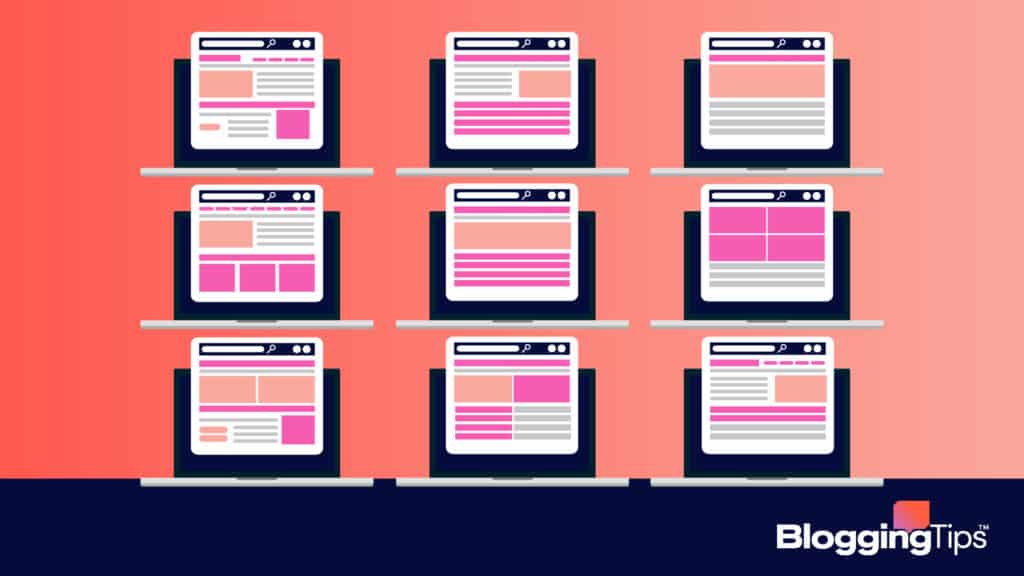
First Blog Post Examples
The best first blog post you can have is one that introduces who you are and why you started your Blog.
This post should be friendly, and welcoming and incentivize readers to come back or read further.
Examples:
A Girl’s Guide to Home DIY
In this post, the author informally introduces who they are and describes their blog.
This introduction is fun and creates a likable personality to which readers can relate.
The Friendly Teacher
In this one, the author is light-hearted and honest.
They introduce themselves through a list of short statements that are sincere and written from the heart.
Blog Examples for Beginners
Everyone starts somewhere. You don’t have to have a huge website or long list of posts to be great.
Many exceptional blogs have humble starts and maintain high-quality content while staying simple.
Examples:
Wandering Earl
The Wandering Earl is a great example of a person who loves traveling and created something from their passion.
The site didn’t start with any grandiose scheme, but continues to run with a simple yet effective format.
A Cozy Kitchen
It’s just a cooking blog about a girl and her dog.
The site’s design is sleek, cute, and each blog post retains a recipe recounted by the author’s experiences.
Blog Examples About Life
Lifestyle blogs are something anyone can do!
They’re a way for people to share their experiences with others and have become quite popular in recent years.
Examples:
The Blog Abroad
The Blog Abroad is about a woman and her life experiences – nothing more, nothing less.
It shows how versatile a blog can be while still remaining simple and easy to manage.
Julie Blanner
This lifestyle blog is one made for everyday living.
There are recipes, house decor, and DIY projects.
Blog Examples for Fashion Bloggers
Fashion blogs are another popular category of blogs that always seem to captivate their audiences.
If fashion is your thing, you might want to consider getting started on your own fashion blog.
Examples:
Wendy’s LookBook
Another person who created something from nothing, Wendy’s LookBook is a beloved fashion blog with a great template and lots of personality.
Egg Canvas
The Egg Canvas is an artsy blog with tons of material on fashion, skincare, and dietary routines.
There’s something charming about how the site is structured, and there’s tons to learn from its style.
Even More Blog Post Examples
For even more blog post examples, check out the following that we’ve included below.
1. The Friendly Teacher
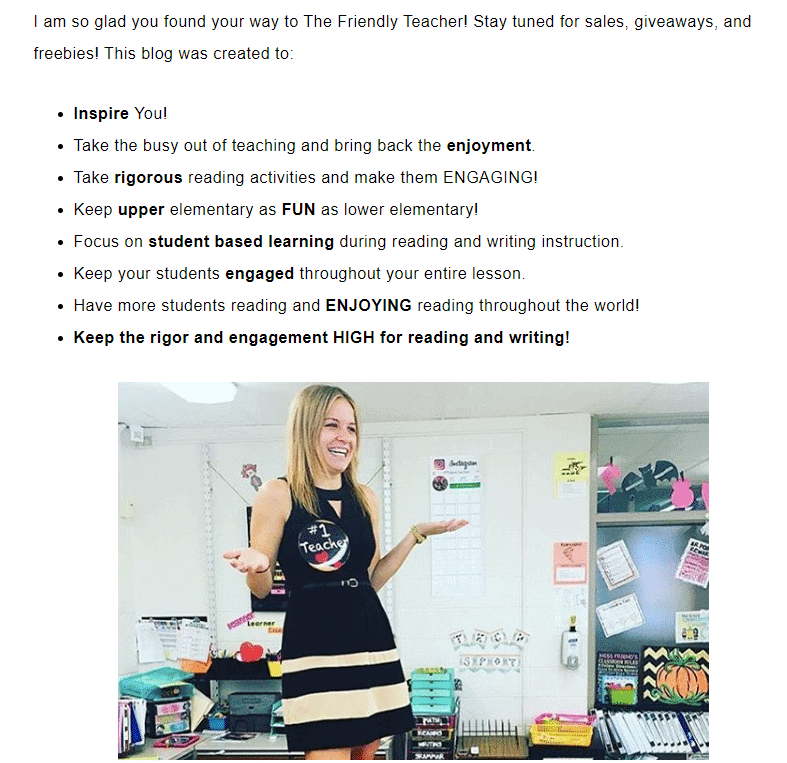
Hannah at The Friendly Teacher does a great job with her first blog post.
It’s an intro that goes over:
- the purpose of her blog
- her background and interests
- her approach to teaching reading
She also announce a giveaway on the page, which is a nice way to kick things off.
Overall, the page is an intro, so it won’t get much traffic over time, but it does do a great job of introducing Hannah, her personality and what she hopes to accomplish with her blog.
2. Gimme Some Oven
I came across Gimme Some Oven when researching mom blog name ideas. Ali keeps it short and sweet on her first post, and this is how it goes for many first blog posts.
3. Fun Cheap or Free
My wife and I follow a lot of Jordan Page’s advice and content at Fun Cheap or Free.
Her first post is straightforward and mentions her goal of highlighting creative ways to save money. I also like that she includes contact information for readers who do come across the post.
4. Young House Love
The first post at Young House Love offers a quick glimpse into what’s to come from bloggers John and Sherry.
It’s quick and to the point, and acts more of a preview than a full introduction to the couple and their blog.
5. Happy Hooligans
The Happy Hooligans’ first post is a great one: it introduces the blog, the goal and also has some nice calls to action to comment, email Jackie or follow them on Facebook.
I also like that the intro posts includes internal links to other blog posts – if you’re going to create an intro post, it will be the most “aged” post on your site, so it’s a great idea to link this page to more content-heavy ones.
6. Michael Hyatt
This post is an interesting example because Michael set up this site as a way to “communicate with our employees on some sort of regular basis.”
He does a great job of laying out why the blog could be effective, and explains what he expects to do with the blog.
Overall, this is a great intro because it explains the how and why behind the blog and its creation.
7. A Girl’s Guide to Home DIY
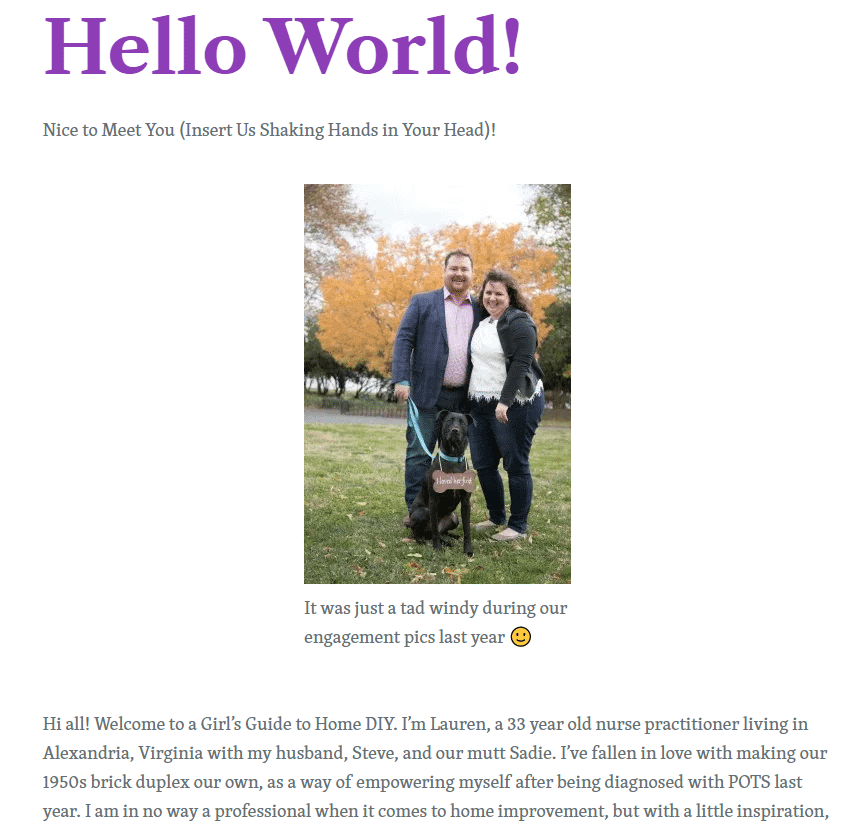
Lauren at A Girl’s Guide to Home DIY does a great job with her first blog post, which goes over:
- her background and interests
- how she started doing DIY home projects
- the goal of her blog
This is one of the best intro posts I came across because there’s a clear story line in Lauren’s content.
She also adds it to the top navigation of her blog for good measure, so this intro post probably gets more traffic than your typical one.
8. Sylvie’s Suitcase
Sylvie has a great intro post that reviews her previous blog, Cotton Tales, and why she focused on travel content with her new blog.
She also includes a few photos and a good idea of what readers can expect from her blog.
9. My Debt Epiphany
Chonce at My Debt Epiphany has a great intro post, going into her background and what her blog will cover.
I also like that she includes a nice bold call to action using ConvertKit, so her intro post can capture more leads than the standard first post.
10. IKEA Hackers
Here’s a quick and easy first post that goes over the basics, and tells readers that Jules is not paid by IKEA to do content.
Nothing crazy, but gets the point across.
11. Cherished Bliss
Ashley at Cherished Bliss posted her first post as a way to update people on her Etsy store.
It’s less of a robust intro and more of an update post, which is a great idea if you have an existing platform or audience from social media, email, Etsy, etc. that already has an idea of what your content, services or products are all about.
12. Domestic Imperfection
Ashley at Domestic Imperfection gets right to the point: this blog is “about all things domestic.”
It’s not a long intro, but it does include an example project so readers can get an idea of what to expect from Ashley’s content.
13. Trips with Tykes
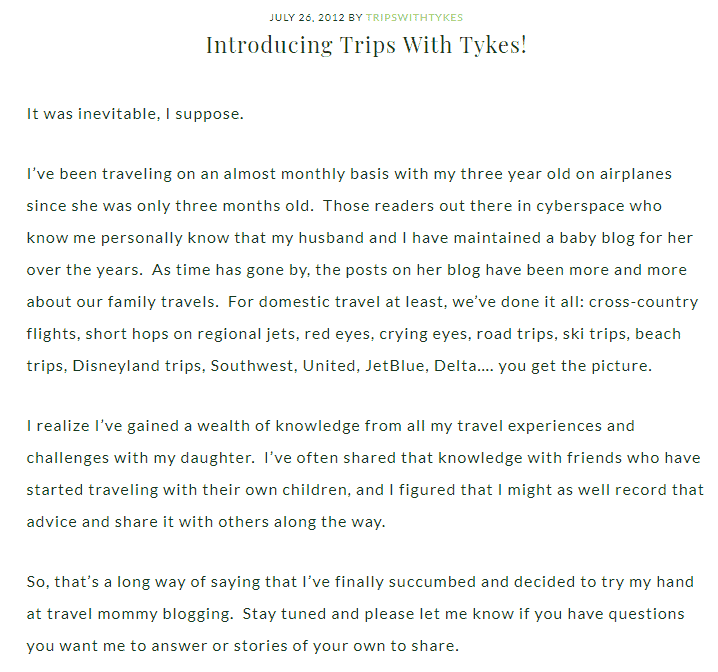
Trips with Tykes’ first post from Leslie covers all the basics: her background and why she started her blog.
14. Have Baby Will Travel
It looks like this post is the first of Have Baby Will Travel’s “updated” blog, and Corinne does a good job of including a call to action to email with input.
15. Beneath My Heart
Here’s a solid all-around intro post from Traci that covers a little background, a little story and some pictures – as well as a call to action to join her email newsletter.
16. At Home with Ashley
Ashley uses her first blog post to spell out her blog vision and purpose.
“I believe my calling in life is to create beauty and I want to help you (yes, you!) have a beautiful life,” she writes. “So here I am blogging about the process.”
17. DIY Beautify
Cindy’s first post on DIY Beautify is all about fear and the pull to create cool things. That’s what blogging’s about for a lot of bloggers, but she does a good job of laying it out simply.
19. Citygirlmeetsfarmboy
This one’s short and sweet and explains that Citygirlmeetsfarmboy is all about “how the world is better when people do what they love.”
Pro Tip: Use Blog Writing Tools for Efficiency
A common misconception is that all beginners should start on a blank document and write everything themselves.
That’s not true, as there are various tools out there to make blog writing exponentially easier.

1. Outline with Frase.io
Frase.io is an AI writing tool that can generate short blurbs of content based on the specifications you put in.
Not only will this save you tons of time, but it will also optimize your content so that it’s engineered to rank higher on search engines.
Will it do everything for you?
Well, no.
But it can help you by researching analytics, creating content briefs, and implementing keywords to help people find your site.
2. Write with Jasper.ai
Another excellent AI writer is Jasper.
Like Frase, Jasper is a cohesive AI writing software that uses SEO techniques to generate creative content for social media and blog posts.
It’s an amazing way to significantly speed up the writing process and ensure that your content is both high quality and optimized to rank high in search engines.
Wrapping Up
Navigating your first blog posts doesn’t have to be an agitating, time-consuming experience.
There are so many tools and examples to work with nowadays that starting a blog has never been easier!
If you follow all the templates and examples outlined in this article, you should have no problem getting to work on your next blog post.
Are you looking for more tips and insights on blog writing?
Check out even more helpful guides:
Still stuck on what to write about? Check out our list of over 200 blog ideas for even more inspiration and guidance.





